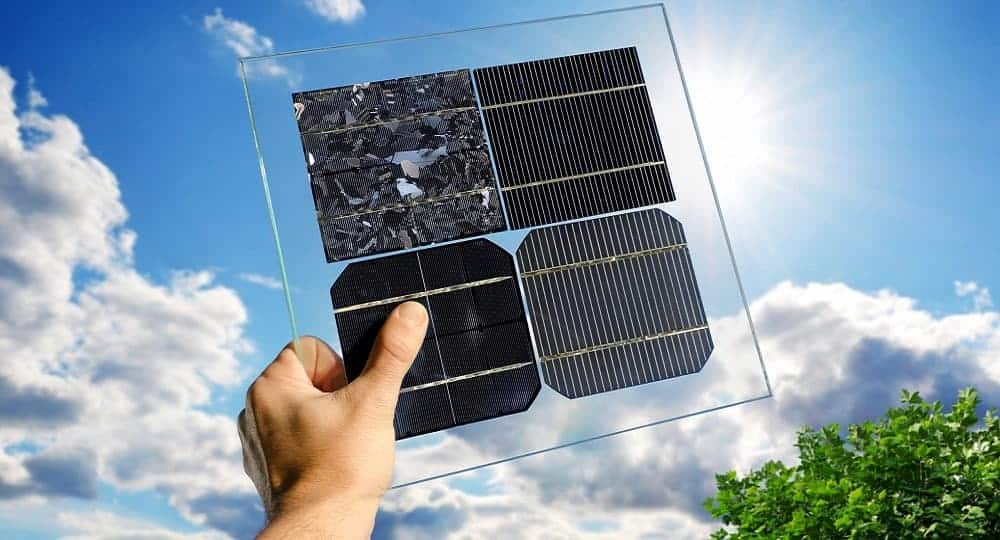Photovoltaic (PV) cells in large numbers make up sun energy solar panels. Solar cells on solar panels absorb photons, the sun’s energy packets, when sunlight strikes their surface. As a result, the cells become excited and begin to vibrate, producing green electricity. The Photovoltaic effect, which was first identified in 1839 by Edmond Becquerel, is what causes this.

Monocrystalline Solar Panels
The most advanced and oldest form of solar panel is monocrystalline. Monocrystalline Solar Panels are, as the name implies, constructed of silicon solar cells with a single crystal. These solar cells are created by cutting pure silicon into wafers and forming it into bars. To help the solar cells generate even more electricity, the cell edges are removed, smoothed out, and rounded off during this procedure. This provides the monocrystalline cells a recognizable appearance despite being highly time- and resource-consuming.
Monocrystalline Solar panels are a premium panel that are produced from silicon that has the highest purity. Despite being more expensive, monocrystalline cells offer higher efficiency and a propensity to survive longer. The cells also produce more power because they are made of a single crystal.
Polycrystalline Solar Panels
Polycrystalline panels, also known as “multi-crystalline,” are frequently regarded as the mid-range panel. Polycrystalline solar panels are more affordable, despite being less effective.
Like monocrystalline solar panels, polycrystalline cells are made of silicon. While many fragments of Poly silicon crystal are fused together to form polycrystalline cells. As a result, polycrystalline solar panels are less effective and last for a shorter period of time. Consequently, they are not as effective in producing solar energy from the sun as monocrystalline panels are. This is because each cell comprises several crystals, which restricts how freely the electrons can flow.
Thin-Film Solar Panels
Thin-film solar panels have a low profile, are flexible, and are less bulky than monocrystalline and polycrystalline solar panels. This is due to the fact that the panels’ cells are about 350 times thinner than the crystalline wafers used in conventional monocrystalline and polycrystalline solar panels.
Layers of semiconducting substances, such as silicon, cadium telluride, and copper indium gallium selenide, are used in the production of thin-film solar panels. A glass layer that serves to reflect sunlight is positioned on top of the semiconductor layer and between transparent conducting layers. However, silicon is not the same as solid silicon wafers when it is used to create thin-film solar panels.
Types of Solar Panels You Should Know
Photovoltaic (PV) cells in large numbers make up sun energy solar panels. Solar cells on solar panels absorb photons, the sun’s energy packets, when sunlight strikes their surface. As a result, the cells become excited and begin to vibrate, producing green electricity. The Photovoltaic effect, which was first identified in 1839 by Edmond Becquerel, is what causes this.
Monocrystalline Solar Panels
The most advanced and oldest form of solar panel is monocrystalline. Monocrystalline Solar Panels are, as the name implies, constructed of silicon solar cells with a single crystal. These solar cells are created by cutting pure silicon into wafers and forming it into bars. To help the solar cells generate even more electricity, the cell edges are removed, smoothed out, and rounded off during this procedure. This provides the monocrystalline cells a recognizable appearance despite being highly time- and resource-consuming.
Monocrystalline Solar panels are a premium panel that are produced from silicon that has the highest purity. Despite being more expensive, monocrystalline cells offer higher efficiency and a propensity to survive longer. The cells also produce more power because they are made of a single crystal.
Polycrystalline Solar Panels
Polycrystalline panels, also known as “multi-crystalline,” are frequently regarded as the mid-range panel. Polycrystalline solar panels are more affordable, despite being less effective.
Like monocrystalline solar panels, polycrystalline cells are made of silicon. While many fragments of Poly silicon crystal are fused together to form polycrystalline cells. As a result, polycrystalline solar panels are less effective and last for a shorter period of time. Consequently, they are not as effective in producing solar energy from the sun as monocrystalline panels are. This is because each cell comprises several crystals, which restricts how freely the electrons can flow.
Thin-Film Solar Panels
Thin-film solar panels have a low profile, are flexible, and are less bulky than monocrystalline and polycrystalline solar panels. This is due to the fact that the panels’ cells are about 350 times thinner than the crystalline wafers used in conventional monocrystalline and polycrystalline solar panels.
Layers of semiconducting substances, such as silicon, cadium telluride, and copper indium gallium selenide, are used in the production of thin-film solar panels. A glass layer that serves to reflect sunlight is positioned on top of the semiconductor layer and between transparent conducting layers. However, silicon is not the same as solid silicon wafers when it is used to create thin-film solar panels.